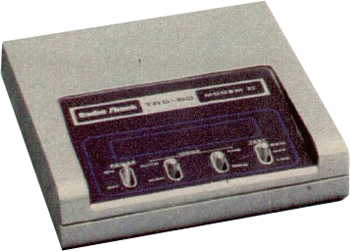Today, downloading an image from the Internet takes mere seconds. It’s not a big deal. Yet, I remember in the 1990s, when I originally crafted the Wambooli website, I made sure that all the graphics were about 50K in size. I didn’t want someone to grow old while the page loaded.
Page load times are insignificant today. In fact, downloading huge images and video files happens nearly instantaneously, thanks to broadband Internet.
But take yourself back in time to the days of the microcomputer, back when the Apple II reigned and the Commodore 64 vied for second place with the TRS-80.
A computer system back then didn’t have a hard drive. That’s because your typical 5MB hard drive cost several thousand dollars. Even so, those early operating systems couldn’t deal with that much storage: The 10MB hard drive attached to my TRS-80 Model III at work had to be partitioned into multiple “logical” drives so that I could use it.
Computers used floppy drives for storage, or they used cassette tape, but most nerds saved up and purchased a floppy drive. That drive gave you about 100K or 200K of storage. That was plenty, especially given that usable RAM topped out at 64K.
Modems were around back then, but they ran at a piddly 300BPS. I believe the 1200 “baud” modems were available, but horrendously expensive.

Figure 1. My very first modem.
Given a typical computer configuration, assume you wanted to download a 1.2 megapixel JPEG file, basically a typical image file you’d see on Reddit or 9gag.
First, it would take you over two hours to do the transfer. That’s assuming that the call (because it was a dialup modem) wasn’t interrupted and no packets needed to be re-sent.
Second, you wouldn’t be able to store the JPEG file in a standard computer configuration. You might find a utility that could spool a 1.2MB (approximate) file across several floppy disks. Doing so as the file was received, however, would be problematic: microcomputers didn’t multitask. The transfer would have to wait while information was written to disk.
Finally, assuming that the file was saved to disk, you absolutely could not load it into memory. Even if the system had the full 64K of RAM, you’d need nearly 20 times that amount to load the full image. Further, the monitors of the day lacked the graphics depth to properly display the image. A hacker might be able to cobble together code to sample the image and display it at low resolution, but what’s the point?
Even an early IBM PC, packed with 640K of RAM, a hard drive, and CGA graphics, wouldn’t be up to the task.
So when you see a typical 1.2 megapixel image appear on the screen on a web page, and it loads in no time, show some appreciation. Things could be worse.


Mmmm,but there were less cat pictures…
Comment by glennp — August 16, 2016 @ 2:55 am
Indeed. That’s a recent phenomena. The first images I remember seeing were landscapes and such, used in the stores to demonstrate the “high resolution” monitors of the day. Cats happened when regular humans started populating the Internet.
Comment by admin — August 16, 2016 @ 6:47 am